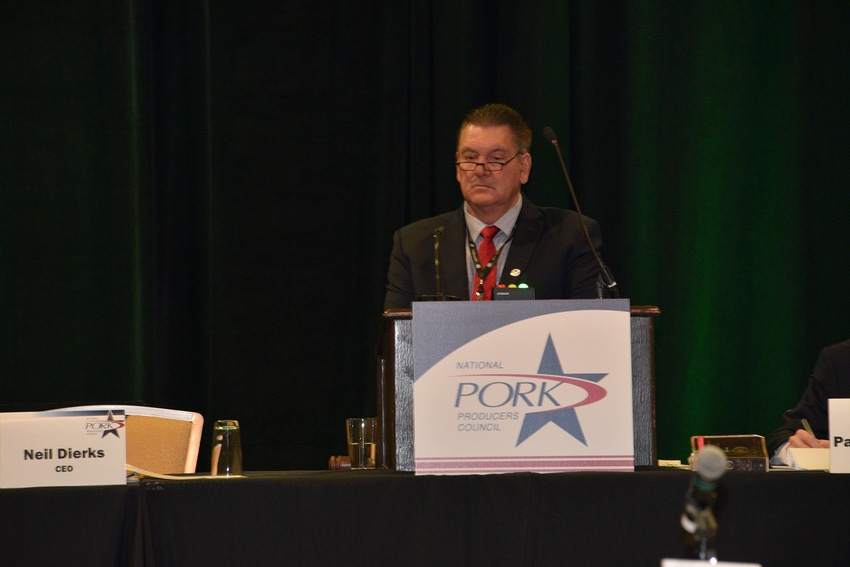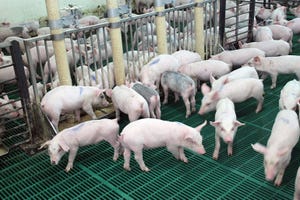From overseeing the farm bill signing to moving trade deals forward with Canada, Argentina, Mexico and Colombia, Jim Heimerl never veered away from his mission to represent the U.S. pork industry.

From the time Jim Heimerl took office last March until he passed the gavel on last week at the National Pork Producers Council’s annual meeting, it has been a rollercoaster ride of retaliatory tariffs and market uncertainty.
“Our industry is in challenging times right now,” says Heimerl, who served as the 2018-19 NPPC president. “As you have heard many times we have been good patriots during this administration while Washington has done the trade negotiations, but we are at the tip of the spear.”
The Johnstown, Ohio producer, who is now NPPC immediate past president and chairman of the organization’s Trade Committee, took on those challenges head first over the past year. “Big Jim” as he was affectionately called by his fellow board members, listened intently to producers’ concerns and worked diligently to represent their best interests on Capitol Hill.
“I know many trips have fallen on deaf ears in Washington, but like our staff says we keep pounding it in,” Heimerl says. “Like they say, a squeaky wheel gets oiled first. Although many efforts seemed at times fruitless, it qualified our mission to get those folks to understand our plight.”
From attending President Trump and First Lady Melania Trump’s White House Christmas Party and overseeing the farm bill signing to ringing the bell at the New York Stock Exchange and moving trade deals forward with Canada, Argentina, Mexico and Colombia, Heimerl never veered away from his mission to represent the U.S. pork industry.
He says he believes the pork industry has a good friend in U.S. Secretary of Agriculture Sonny Perdue as he understands the toll the trade wars have taken on pork exports and he is committed to increasing resources at the U.S. Customs and Border Patrol to protect our country from foreign animal diseases.
“It’s been very enlightening and exciting to be there with him,” Heimerl says. “I hope he makes some good headway and can level the playing field.”
If the tariffs were lifted in China or Mexico, he says either of these would be a success that would help the U.S. pork industry’s financial bottom line immensely. With a fifth new packing plant starting up last week and production up 4%, trade will always be paramount to our industry, but Heimerl says he thinks a 30% to 32% export market is attainable.
Seeing the passage of the 2018 farm bill is one of Heimerl’s significant accomplishments during his term in office. The bill included partial funding for an FAD vaccine bank as well as more resources for laboratory preparations. It was a victory for pork producers and a point of pride for Heimerl.
He also helped the organization address several ballot initiatives that restricted the way pork producers do business and oversaw the USDA’s record purchase of $558 million of pork for food banks, which aids farmers in response to trade damage from unjustified retaliation.
Along with those successes Heimerl recognizes comes challenges for the road ahead for the industry.
“Japan has always been our No. 1 dollar leader relative to trade,” Heimerl says. “Courting Japan as a prom date to TPP only to leave her on the front door step in the transition has led our industry into a lot of expansion which I believe was modeled after our TPP agreement. Our efforts to produce a bilateral agreement will always be a priority.”
While a trade agreement with South Korea was a great win that kept the U.S. pork industry in the game, Mexico and China need to be ironed out next.
“Trade will continue to be our forefront and our hill to die on,” Heimerl says. “The importance of tariffs efforts to forge relations with those countries are crucial to our bottom line.”
The Massachusetts and California Prop 12 legislation will also need to be addressed.
“How can we let a group of people dictate the best practice for our animals such as square footage and antibiotic-free stipulations?” Heimerl says. “The NPPC staff continues to monitor these concerns and hope to keep our interest as well the animals at the front of these conversations.”
Along with well-detailed issues affecting the industry, Heimerl acknowledges there are many “hair on fire” issues that affect us every day and the NPPC staff are the ones who need to be thanked.
“Many times, I wish everyone in this room could be a board member to collectively look behind the curtain to see just how important the staff at NPPC are to contributing to the success of this organization,” Heimerl says. “Unfortunately, it seemed like this past year we have been more on the defense and fighting for preservation and the core and principles of our industry, and spending less time playing offense than we could be.”
Heimerl is grateful pork producers entrusted him with leading the organization over the past year and giving him the opportunity to give the minority a voice.
“There are less than 2% (of the populaiton) involved in the agriculture industry, and much less involved in producing a great source of protein we call pork,” Heimerl says. “If we don’t speak out from hearts in determining our future, the 98% will make it a mission to speak against our success or make it a mission to speak out on our behalf.”
About the Author(s)
You May Also Like





